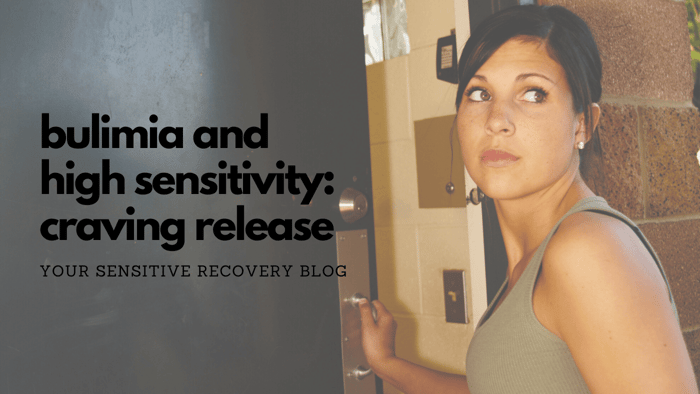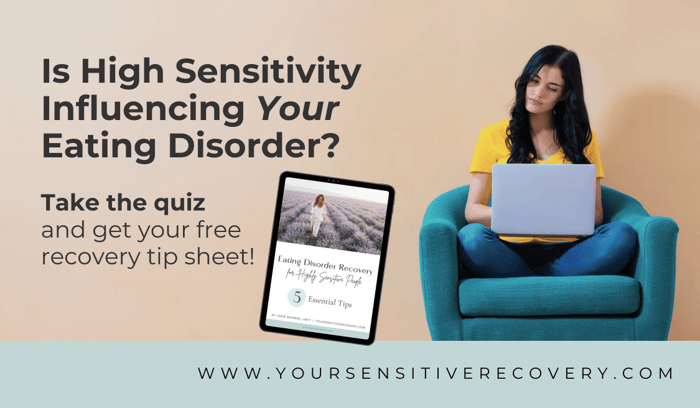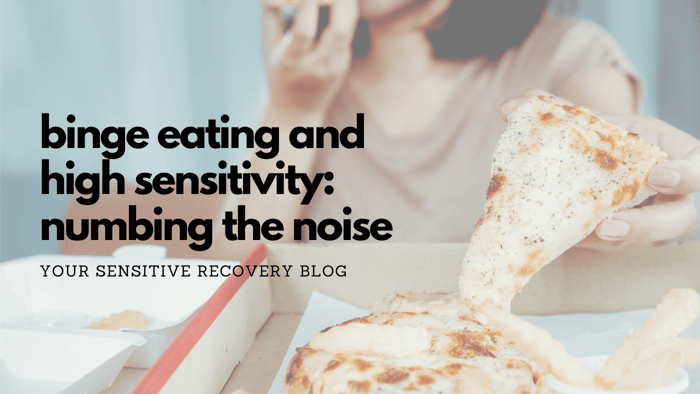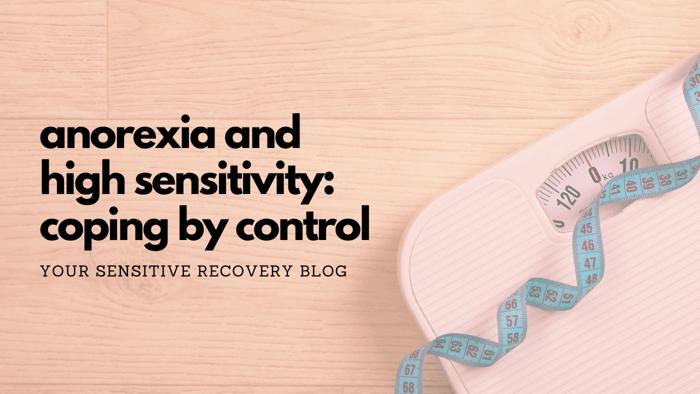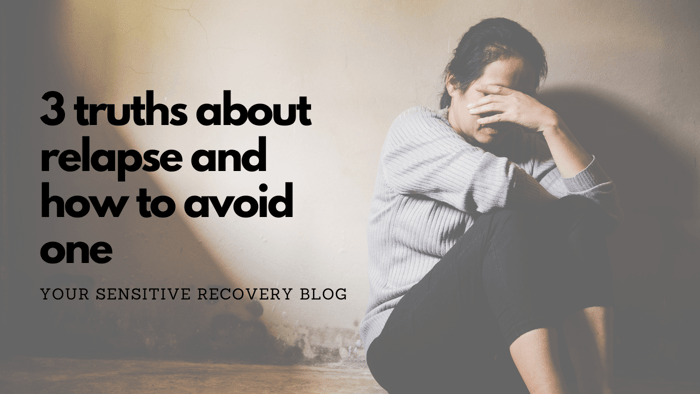Welcome to post number 3 in my blog series exploring High Sensitivity in different eating disorder diagnoses. This week, I’m focusing on Bulimia Nervosa, a disorder defined by the binge-purge cycle. For some Highly Sensitive People (HSPs), bulimia develops as a way to regulate overwhelming emotions and sensory overload. Often misunderstood as simply a problem with impulsivity or a lack of self-control, the cycle of bingeing and purging serves a deeper purpose, and especially for a certain subset of HSPs (more on that soon), it can act as both an escape and a release.
Let’s move beyond shame and stigma and explore how High Sensitivity can contribute to the development of bulimia. By better understanding what needs to be addressed for true healing, those struggling can break free from the damaging and painful cycle.
👉 NOTE: While this post focuses on Bulimia Nervosa, much of the information can also apply to folks with Other Specified Feeding and Eating Disorders (OSFED), or non-diagnosed disordered eating where binging and purging behaviors are present.
Are You a Highly Sensitive Person?
If you’ve ever been told you’re “too emotional” or “too sensitive,” you might be among the 15-30% of the population who are Highly Sensitive People. High Sensitivity, also known as Sensory Processing Sensitivity, is a biological trait that causes the nervous system to absorb and process information to a greater depth and degree. HSPs don’t just pick up on more information - they feel more, think more, and can react more intensely to the world around them.
"When I look at my partner's face I can immediately tell if something's bothering them. I can get a little obsessed about the tiny shifts in their expression, and then fixate on whether or not I caused those shifts." - Skye (35yrs)This heightened awareness of the HSP's inner and outer world comes with many strengths, but it also can present challenges, especially in a society where sensitivity is synonymous with weakness.
Strong emotions (both your own and other people’s), and fast-paced or high-pressure environments can easily lead to overstimulation. When there’s no time or space to process everything, it can feel like too much to hold.
Without understanding their sensitivity, many HSPs develop coping strategies to manage the intensity of their experiences. Some withdraw, others seek the illusion of control, and for some, the need for both stimulation and relief leads them to a cycle of binging and purging food.
Understanding Bulimia
Bulimia Nervosa is an eating disorder characterized by cycles of binge eating followed by compensatory behaviors to prevent weight gain. Unlike Binge Eating Disorder, where episodes of excessive eating occur without purging, bulimia involves an urgent need to “undo” a binge. Purging behaviors can include not only self-induced vomiting but also the misuse of laxatives or diuretics, excessive exercise, fasting, and other behaviors aimed at eliminating calories or regaining a sense of control.
While binge eating in bulimia can provide a temporary reprieve from emotional overwhelm or sensory overload, the purging phase of the cycle adds another layer to the disorder.
Purging acts as a way to release tension and restore balance after a period of feeling out of control. However, this cycle ultimately causes not only physical harm to the body but also a great deal of shame. For Highly Sensitive People, who experience emotions and sensations more intensely, bulimia can seem to help someone cope with shame, while unfortunately reinforcing it at the same time. Understanding the connections between this eating disorder and High Sensitivity is key to developing a more compassionate and effective approach to healing.
Sensitivity, Sensation-Seeking, and the Binge-Purge Cycle
While many Highly Sensitive People attempt to avoid stimulation to prevent overwhelm, a subset of HSPs are actually High Sensation Seeking (HSS) sensitives, meaning they crave novelty, excitement, and intensity. This creates a unique internal conflict.
An HSS-HSP individual might feel a deep need for calm and predictability, yet also a strong drive to seek out stimulating, and even high-risk experiences.
It's like having the heart of an explorer inside a homebody’s soul; always pulled between the excitement of the unknown and the comfort of the familiar.
Bulimia, an intensely sensory experience fits the bill for some folks, providing both the rush of binge eating and the relief of purging. The textures, flavors, and sheer volume of food in a binge can create a temporary sense of escape and excitement. Purging acts as a "reset," reinforcing a cycle of highs and lows that can be difficult to break.
"I can't tell you how much I look forward to a binge-purge. At this point, it's like I don't even crave the food anymore, but more the whole experience." - Malia (22 yrs)Over time, some individuals with bulimia may begin to meticulously plan out their binge-purge episodes in advance, looking forward to them as a form of stress relief, distraction, or even as a reward for enduring difficult emotions or situations. This pattern aligns with the HSP/HSS tendency to seek out intense experiences, even when those experiences have negative consequences.
A Sensitive-Supporting Recovery
For HSPs, especially those with sensation-seeking tendencies, breaking free from bulimia requires addressing both the need for emotional and sensory soothing and the craving for intensity and or/release. Finding alternative ways to experience stimulation, can help put the binge-purge cycle "out of its job."
Key Areas to Focus on in Recovery:
- Keep Learning About High Sensitivity: Research your trait and start focusing on its strengths, not just its liabilities.
- Address Impulsivity With Awareness: Practice pause and delay techniques, like urge surfing or grounding exercises which can help create space between impulse and action.
- Balance Stimulation With Rest: HSS-HSPs crave novelty but also need downtime (like all HSPs) to avoid burnout. Your recovery should intentionally include both.
- Channel Sensation Seeking Into Healthier Outlets: If your binging and purging feels like an adrenaline-fueled escape, seek out alternative, healthy ways to engage the nervous system. Think sports, art, music, dance, and travel.
- Grieve the Struggles: Acknowledge the difficulty of living as a sensitive person in this world, and if applicable, the tug-of-war that you may face as an HSS-HSP.
- Tap Into Curiosity: Reframe recovery as a journey of discovery rather than a rigid set of rules you have to follow. This can better align the process with your nature and your needs.
You're Not Broken
If you’re a Highly Sensitive Person struggling with bulimia or a High Sensation Seeking HSP caught in this challenging cycle, know this: you are not broken. Your sensitivity is not a flaw, and your need for both comfort and stimulation is not a contradiction. These traits may have shaped your eating disorder, but they can also shape your healing.
Recovery isn’t about changing who you are. It’s about learning to accept the truest version of yourself and work with your sensitivity instead of fighting against it. By understanding your unique needs, creating a supportive environment, and finding healthier ways to regulate and seek excitement, you can break free from the binge-purge cycle.
You are worthy of healing, just as you are. ✨
* Names and other identifying details have been changed to protect privacy.
✨ Josie Munroe, LMFT is a licensed therapist and owner of JosieMunroe.com and Your Sensitive Recovery. As a recovered clinician and Highly Sensitive Person, she loves supporting others on their journeys to form new, empowered relationships with food, their bodies, and their sensitivity. Join the newsletter for a weekly boost of hope and inspiration. You deserve a recovery that works for you! ✨

